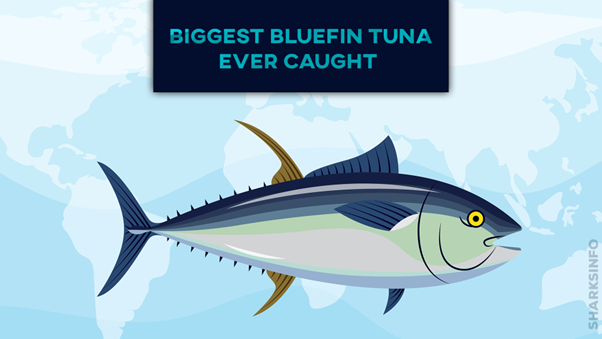A tuna is a fish of saline water habitat which belongs to a family of Scombridae, the family comprises 15 species. The length and weight of tuna vary from species to species. Moreover, the Atlantic Bluefin Tuna is the largest species of Scombridae. To know more about these species scroll down to find out some of the interesting facts about them as well.
What Habitat Do Does Biggest Bluefin Tuna Adapt?
The Biggest Bluefin Tuna are the species of cold waters of Iceland and the tropical waters of the Mediterranean Sea, the Gulf of Mexico, and North American and European waters which they visit several times a year.
What Does The Biggest Bluefin Tuna Look Like?
The Atlantic Bluefin Tuna are the fastest, largest, and the colorful species of the world’s realm that have torpedo sharped streamlined, and slender bodies. They have a metallic blue coloration with sliver and white shimmering which help them in camouflage and provide them protection from predatory animals.
How Long Can The Biggest Bluefin Tuna Be?
On average, the Tuna can reach up to 50 cm or 1.6 feet in length and weigh about 4 pounds or 1.8 kg. Focusing on the Biggest Bluefin Tuna, the largest species of the Tuna have a maximum length of 6.5 feet and weighs about 550 pounds but the largest species caught can have a length of 15 to 16 feet or 4.6 to 5.6 meters and are the heavier species that weigh about 1,508 pounds or 684 kg.
Why did The Bluefin Tuna Do Get So Big?
The Bluefin Tuna get so big because they eat a lot, more than you have ever imagined. Bluefin Tuna, other than sharks, are the popular predatory animals that play a very dominant role in the food chain. On average, Bluefin Tuna eats 5 to 15% of their total body weight.
Further, these voracious animals include large animals in their diet such as whales, humans, sharks, and large fishes like herring, Marlin, and mackerel. The Tuna wander in the open waters only and only in search of food. These species live for about 35 to 50 years which gives them enough time to eat and grow.
What Is The Biggest Bluefin Tuna Ever Caught?
On October 1957, the well-known Tuna fisherman Ken caught the enormous Biggest Bluefin Tuna near the coast of Nova Scotia, Canada. Once he hooked the giant Tuna, the heavyweight and extreme length took 45 minutes for Ken to take the measurement. The incredible species have been mentioned in the Guinness Book of World Records.
How The Fisherman Caught The Biggest Bluefin Tuna?
The fisherman uses rods and reels to catch the Tuna; the bait consists of hooks and short lines having food to attract the Tuna. The fisherman uses large nets because these fishes usually travel in schools. Once, the fish got trapped, they pull the net towards the boat, drag the large Tuna inside and throw the rest of the fish back into the water.
Are There Any Other Species Of Bluefin Tuna That Have Ever Caught?
There are a few species of Bluefin Tuna that have been caught. Some of them are listed below:
1: Southern Bluefin Tuna: These species are spotted in the Tathra water of Australia on July 9th, 2009.
2: Atlantic Bigeye Tuna: These species are sighted in the waters of Puerto Rico, Gran Canaria, Spain on July 25th, 1996 for the first time.
3: Pacific Bigeye Tuna: They are seen on April 17th, 2014 for the first time in Cabo Blanco, Peru.
4: Pacific Bluefin Tuna: On February 19th in the open waters of Three Kings, New Zealand, these species were first seen.
Conclusion
Among all the specie of Tuna, Atlantic Bluefin Tuna is the largest species that have ever landed on the Earth. The species have a maximum length of 15 to 16 feet or 4.6 to 5.6 meters and are the heavier species that weigh about 1,508 pounds or 684 kg. The enormous size and heavy weight make it a bit difficult to catch the Atlantic Bluefin tuna- the king of the marine habitat.







